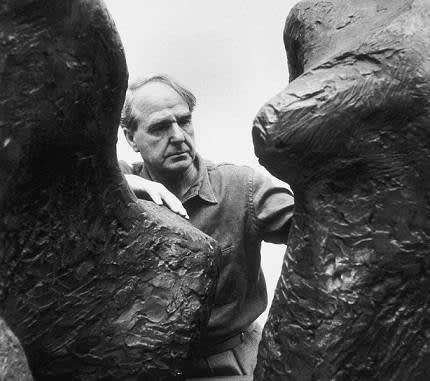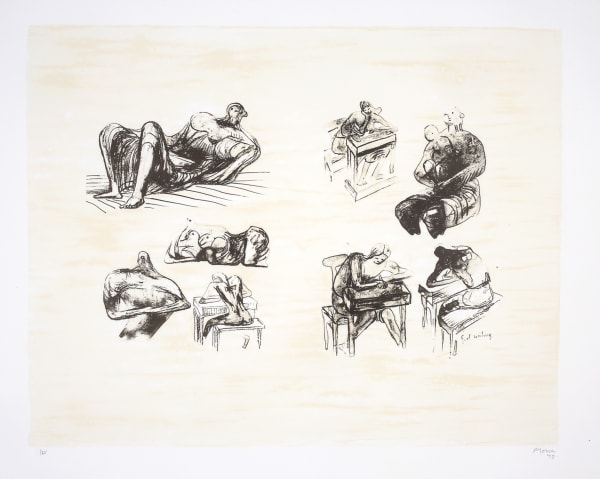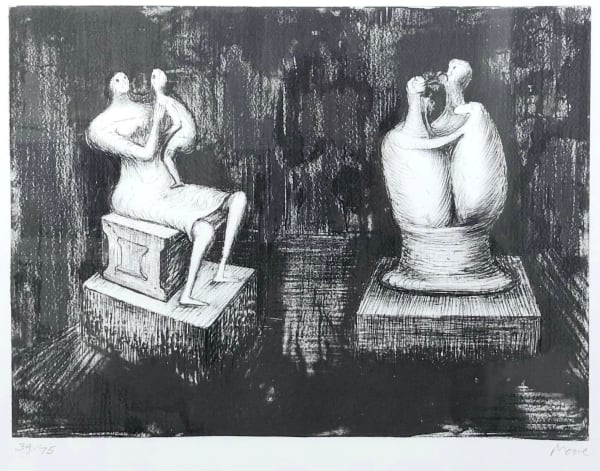Henry Moore U.K., 1898-1986
Henry Spencer Moore was one of the most important British artists of the twentieth century, and arguably the most internationally celebrated sculptor of the period. He is renowned for his semi-abstract monumental bronzes, which can be seen all over the world.
Moore was born in Castleford, a small mining town in Yorkshire, in 1898. After training to be a teacher and serving in the British Army he studied at Leeds School of Art and then the Royal College of Art, London. By the 1950s Moore had begun to receive a number of international commissions. He continued working in sculpture, drawing, printmaking and textile design until his death in 1986.
Moore was a pioneer of modern sculpture, and his work came to symbolise post-war modernism and can be said to have caused a British sculptural renaissance.
The foundation of Moore's approach was direct carving, something he derived not only from European modernism, but also from non-Western art. He abandoned the process of modeling (often in clay or plaster) and casting (often in bronze) that had been the basis of his art education, and instead worked on materials directly. He liked the fierce involvement direct carving brought with materials such as wood and stone. It was important, he said, that the sculptor 'gets the solid shape, as it were, inside his head... he identifies himself with its center of gravity.'
Related to his commitment to direct carving was a belief in the ethic of 'truth to materials.' This was the idea that the sculptor should respect the intrinsic properties of media like wood and stone, letting them show through in the finished piece. A material had its own vitality, Moore believed, 'an intense life of its own,' and it was his job to reveal it.
Just as the human body inspired Moore's forms, so too did the natural world. He often derived ideas from objects such as pebbles, shells and bones, and the way he evoked them in his sculpture encouraged the viewer to look upon the natural world as one endlessly varied sculpture, created continually by natural processes. Evoking both the natural world and the human body simultaneously in his work, Moore created a picture of humanity as a powerful natural force.
During his lifetime, Moore became synonymous with modern sculpture in England, America and beyond, introducing a wide public to modern styles such as Surrealism and primitivism. Indeed he is almost synonymous with the many worldwide institutions outside which his grandest public sculptures stand, encapsulating their humanitarian mission. His reputation has declined since his death, a consequence in part of the prolific production of his later years, and in part due to a distaste for his soft, sometimes cloying humanism. Yet he undoubtedly had a great impact on the generation that followed him, inspiring figures as diverse as Eduardo Paolozzi, William Turnbull, and - because they were at one time assistants in his studio - Anthony Caro and Phillip King.
-
 Henry MooreMother and Child, 1983view more details
Henry MooreMother and Child, 1983view more details -
 Henry MooreMother and Child VI, 1983view more details
Henry MooreMother and Child VI, 1983view more details -
 Henry MooreHead of Woman, 1981view more details
Henry MooreHead of Woman, 1981view more details -
 Henry MooreThree seated figures, 1981view more details
Henry MooreThree seated figures, 1981view more details -
 Henry MooreMothers and child studies, 1976view more details
Henry MooreMothers and child studies, 1976view more details -
 Henry MooreEight Sculptural ideas; Girl Writing, 1973view more details
Henry MooreEight Sculptural ideas; Girl Writing, 1973view more details -
 Henry MooreSculptures: Dark Interior, 1973view more details
Henry MooreSculptures: Dark Interior, 1973view more details -
 Henry MooreThree reclining figures, 1971view more details
Henry MooreThree reclining figures, 1971view more details -
 Henry MooreConcerto, 1967view more details
Henry MooreConcerto, 1967view more details -
 Henry MooreEight Reclining Figures I, 1967view more details
Henry MooreEight Reclining Figures I, 1967view more details -
 Henry MooreViolet Torso on Orange Stripes, 1967view more details
Henry MooreViolet Torso on Orange Stripes, 1967view more details -
 Henry MooreViolet Torso on Orange Stripes, 1967view more details
Henry MooreViolet Torso on Orange Stripes, 1967view more details
-

Post-War/Modern
Art at the OWO 8 October 2024 - 31 January 2025Dellasposa Gallery is delighted to present a new exhibition at The OWO Residences by Raffles in London. This historic venue, once the former War Office, now serves as a unique...Read more -

Printed Perspectives
23 November 2023 - 5 January 2024Dellasposa Gallery is pleased to present Printed Perspectives, an exhibition that bridges the gap between modern and contemporary as it showcases the diverse and innovative printmaking practices of Barbara Hepworth, Lynn Chadwick, Howard Hodgkin, Henry Moore, and Graham Sutherland. This curated collection invites you to witness the evolution of printmaking across movements, offering a unique lens into the visions of these influential artists.Read more














